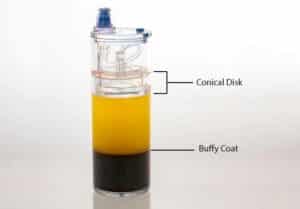When we centrifuge blood we stratify, or separate, it into layers based upon the density of the different nucleated and non-nucleated cellular components. Each of these blood components performs a very specific task. By separating them we can isolate them into a supraphysiologic concentration. When we create Platelet-Rich-Plasma (PRP) we are separating and isolating as many platelets as possible from a sample of whole blood and then suspending them into a small amount of plasma. In terms of density stratification leukocytes are close neighbors to platelets. Because of this much debate has centered around whether to include or exclude these leukocytes from final PRP preparations. In previous articles we’ve discussed the difference between how to concentrate PRP via either a dual or single spin. We’ve also discussed concentrating platelets for delivery in either plasma (PRP) or fibrin (PRF). In this article we will be discussing leukocyte rich vs leukocyte poor PRP where rich and poor refer to the inclusion or exclusion of leukocytes respectively.
What are Leukocytes?
Leukocytes are another name for white blood cells. They account for about 1% of a sample of whole blood. There are 5 different types of white blood cells. The first two are Monocytes and Lymphocytes. Monocytes defend against infection by removing damaged cells and Lymphocytes are the T cells and B cells that protect against viral infections and create antibodies. The final three, known collectively as granulocytes, are Neutrophils, Eosinophils, and Basophils. The term “granulocyte” is derived from the small granules of protein contained within the cytoplasm of these leukocytes. Neutrophils help protect against infection by killing bacteria. Eosinophils identify and destroy foreign parasites. Basophils defend your body from allergens.
Where are the Leukocytes?
Since we are looking at this from a density gradient separation standpoint, it is helpful to understand the different densities of white blood cells. The median densities of monocytes and lymphocytes are 1.067-1.077 and 1.073-1.077 g/ml respectively. Granulocytes have densities ranging from 1.079-1.083 g/ml. In our single spin vs dual spin article, we discussed platelets having a density of 1.060-1.067 and red blood cells 1.086-1.090 g/ml. At the conclusion of a cycle of density centrifugation, based upon the densities, the white blood cells will situate themselves between the platelets and red blood cells. Since white blood cells make up roughly 1% of a whole blood sample this results in a thin band forming at this platelet/red blood cell interface, which we call the buffy coat.
How do you create LR-PRP or LP-PRP?
The first step is to choose an FDA approved high quality PRP kit such as the EmCyte Pure PRP kit. This PRP kit has two separate protocols that will allow you to create either a leukocyte rich or leukocyte poor PRP. EmCyte’s Pure PRP tube is designed with a conical disk that sits above the whole blood once it is expressed into the tube. After the first centrifugation spin, this disk remains in place so that the separated blood can be drawn off from the top plasma layer down. What you choose to draw off in this layer will determine what your final PRP contains. Remember from our density investigation above, the white bloodcell buffy coat is situated between the platelets and the red blood cells. If you would like to exclude this layer from 2nd spin processing you can stop the disk just as it gets to the buffy coat. This will result in a leukocyte poor (LP-PRP) preparation. If instead you would prefer a leukocyte rich preparation you can dip just slightly into the red blood cell layer when conducting your initial draw of the platelet plasma solution. This will ensure the entire buffy coat is captured and result in a leukocyte rich PRP (LR-PRP) preparation.
Conclusion
Whether or not to use LP-PRP or LR-PRP is up to you as a practitioner and there are many scientific studies that have been conducted to investigate the pros and cons. EmCyte’s Pure PRP kits are engineered to be highly flexible. This flexibility allows you as the practitioner to create a final product that is highly specific to your needs. Whether you are looking for dual spin, single spin, leukocyte-rich or leukocyte-poor PRP – EmCyte can deliver.

